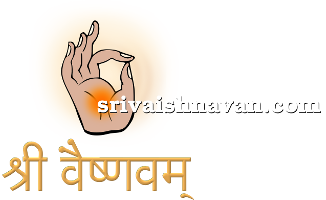What is the importance of Guru or Acharya in our system of philosophy?
To understand the proper meaning of Sastras is very difficult. We have to properly interpret some of the texts, which seem to be conflicting with each other.
There are also inner meanings and secret meanings of the various mantras and slokas.
So, all these things can be properly understood, only by learning under a Guru or Acharya. So, the Acharya is most important, for properly understanding our religion and philosophy.
What is the Chronology of our Sampradaya (Guru parampara). Who is our first Guru?
Lord Narayana is our first Guru. He taught Vedas to Brahma and Brahma in turn taught the Vedas to others. Hence at the head of our line of Gurus is Lord Narayan
Who comes next?
Next in the line of Gurus is naturally our Goddess Mahalakshmi and then comes Vishvaksena or Senai Mudaliyar. This is aterm of respect , traditionally used for denoting Vishwaksena). He is the controller of Vaikunta or Paramapada. Vishwaksena taught Nammalwar or Satakopa the philosophy of Vishistadvaitam.
Who comes next after Vishvaksena?
Nammalwar or Satakopa comes next.
How man the Alwars are there?
There are ten Alwars. Some people include Andal and Madhurakavi and say there are twelve Alwars.
Why were they called Alwars?
‘Alwar’ in Tamil means ‘one who is immersed’. Since these saints were always immersed in the Lord and His qualities, they were called Alwars.
When were they in this world? What was their period?
We say that they were in this world before and near the beginning of Kaliyuga. That is more than 5,000 years ago. The modern research scholars say that the Alwars were between the sixth and ninth century A.D.
Can you briefly tell me about the Alwars?
The first three Alwars are called Poigai Alwars, Bhutattalwar and Peyalwar. All the three together are called the first alwars, because theses three were the first in the line of Alwars and they lived during the same period.
Poigai Alwar was born in the month of Aippasi in the Star Sravanam. Bhutattalwar was born in the month of Aippasi in the star Avittam and the Peyalwar in the same month, in the Star Sathaya on three successive days!
Where were they born?
Poigai Alwar was born at Kanchipuram. Tradition has it that he was born in a tank and hence is called Poigai Alwar. (Poigai = Tank). Bhutattalwar was born in Mahabalipuram and Peyalwar in Mylapore, Madras.
Who came next?
The next Alwar was Thirumazhisai Alwar. He was born in Thirumazhisai near Madras, in the month of Thai in the star Makha.
Then came Nammalwar or Satakopa. He was born at Alwartirunagari in the month of Vaikasi and star Visakha. Nammalwar is considered the chief of the Alwars. He expounded the system of Visishtadvaita Philosophy in clear terms in his works. Hence he is given the greatest importance among all the Alwars.
Next came Kulasekhara Alwar. He was born in the month of Masi and star Punarvasu. His birth place is Vanjikkalam. It is not clearly known as to where exactly this place is. Some people say that it is Karur and some others say that it is in Kerala.
Who came next?
Next was Perialwar, who was born in Srivilliputtur in the month of Ani and star Swati. Andal was found among the Tulasi plants in Srivilliputtur in the month of Adi in the star Puram and was brought up by Perialwar.
What about the other Alwars?
Thondaradippodi Alwar was born in Thirumandangudi near Kumbakonam in the month of Margazhi and the star Kettai. Thiruppanalwar was born in Woriur, near Thiruchi, in the month of Karthikai and the star Rohini.
The last among the Alwars was Thirumangai Alwar, who was born in the month of Karthikai and star Karthikai in Kuraiyalur or Thirunagari near Sirkazhi.
Can you indicate briefly the works of the Alwars?
Nammalwar was the author of four Prabandhas which form part of the sacred 4000 verses, called Divya Prabhandha. The Prabhandhas of alwars in detail:
- Nammazhwar
- Thiruvaimozhi (1102 verses)
- Thiruviruttam (100 verses)
- Thiruvasiriam (7 verses)
- Peria Thiruvandhadhi (87 verses)
The four works are equated to the four Vedas. Thiruvaimozhi, in particular, is called the essence of the Sama Veda.
- Poigai Alwar
- Mudal Thiruvandadi (100 verses)
- Boothalwar Alwar
- Irendam Thiruvandadi (100 verses)
- Peyalwar
- Moondram Thiruvandadi (100 verses)
- Thirumazhisai alwar
- Thiruchanda Viruttam (120 verses)
- Nanmugan Thiruvandadhi (96 verses)
- Madhurakavi alwar
- Kanninun Siruthaambu (11 verses)
- Kulasekhara Alwar
- Perumal Thirumozhi (105 verses)
- Mukunda Mala in Sanskrit (This is not a divya prabandam. His authorship of Mukundamala is disputed by some people.)
- Periyalwar
- Thiruppallandu (12 verses)
- Periyalwar Thirumozhi (461 verses)
- Andal
- Thiruppavai (30 verses)
- Nachiar Thirumozhi (143 verses)
- Thondaradipodi Alwar
- Thirumaalai (45 verses)
- Thiruppalli Ezhuchchi (10 verses)
- Thiruppanalwar
- Amalanadipiran (10 verses)
- Thirumangai alwar. [The last in the list of Alwars is Thirumangai Alwar who wrote six Prabandhas and these are equated to the six angas of the four Vedas of Nammalwar.]
- Peria Thirumozhi (1084 verses)
- Thirukurunthandakam (20 verses)
- Thirunedunthandakam (30 verses)
- Thiruvezhukutrirukkai (1 verse)
- Siriya Thirumadal (1 verse)
- Peria Thirumadal (1 verse)
Who is next in the line of Gurus, after Nammalwar?
After Nammalwar come Nathamuni, who was born in Kattumannar Koil near Chidambaram, in the month of Ani and star Anusham.
His disciple was Uyyakkondar who was born in the month of Chittirai and star Karthikai, in Thiruvellari.
His disciple was Manakkal Nambi who was born in the village Manakal, near Lalgudi in the month of Masi and star Makham.
The next in the line of Acharyas is the great Alavandar of Yamunacharya. He was the grandson of Nathamuni and was the disciple of Manakkal Nambi. Alavandar was born in the month of Adi and star Uttaradam in Kattumannarkoil.
Please tell me further the line of Acharyas.
Alavandar’s disciple was Peria Nambi who was born in Srirangam in the month of Margazhi and star Kettai.
Then comes the great Ramanuja.
Afterwards, there are two lines. There is one line of Acharyas of whom Vedanta Desika was the most prominent. There is another line of Acharyas which goes on to Manavala Mamunigal.
Ramanuja (1017 A.D. – 1137 A.D.) was born in Sriperumpudur in the month of Chitrai and star Thiruvadirai.
Vedanta Desika (1268 A.D. – 1369 A.D) was born in Thoopul near Kanchipuram in the month of Purattasi and star Sravanam.
Manavala Mamunigal (1370 A.D. – 1443 A.D.) was born at Sikkil Kidaram, in the month of Aippasi and star Mulam. It is also said that he was born in Alwartirunagari.
But I heard that Ramanuja had five Acharyas?
Yes.
- Peria Nambi was the chief or principal acharya.
- Ramanuja learnt meanings of secrets (rahasyas) form Thirukkottiur Nambi.
- He studied Thiruvaimozhi under Thirumalai Andan.
- He learnt stotras Alavandar Alwar
- He studied Ramayana under Thirumalai Nambi.
Thus he had five acharyas.
What are the other names of Ramanuja?
Ramanuja is also called Bhashyakara, Yatiraja, Udayavar, Emberumanar and Yatiswara
Can you indicate briefly the works of these great acharyas?
- Nathamuni gave us two works.
- Yoga Rahasya
- Nyayatattva
- Alavandar gave to this world 8 works.
- Agama Pramanya, Purusha Nirnaya.
- Three Siddhis called Siddhi Trayam, namely, Atma Siddhi, Iswara Siddhi and Samvit siddhi.
- Then Gitartha Sangraha, Stotra Ratna and Chathus Sloki.
- The next great Acharya Ramanuja gave us nine works or nine gems.
- Sri Bhashya
- Vedanta Dipa
- Vedanta Sara
- Vedartha Sangraha
- Gita Bhashya
- The Three Gadyas, namely Saranagati Gadya, Sriranga Gadya and Vaikunta Gadya
- Nitya grantham
The works of Vedanta Desika are more than 100 in number. They cover different fields like devotional stotras, kavya, drama, works on philosophy, and commentaries on great works.
It is a wonder how a person could write so many works within a life span. It is difficult for us even to read and understand all his works in a lifetime.
What are the most important works of Sri Desika?
All works are equally important. I will give you the name of some of the works. Rahasyatrayasara is a book which gives in detail the inner meaning of the three secrets or rahasyas. In the process, it expounds our Vaishnavite philosophy. It also dwells at length on the prapatti or saranagait as the means of attaining salvation.
What are some of the other works of Desika?
We have Taparya Chandrika. This is a lucid commentary on the commentary of Bhagavad Gita that was written by Ramanuja. Paduka Sahasra describes the greatness and beauty of the paduka of Sri Ranganatha in 1000 verses. Yadavabhyudaya gives the story of Sri Krishna. The slokas of Yadavabhyudaya are full of something supreme. It is because of the greatness of this work that it has been commented upon by Appayya Dikshitar, the great Advaita scholar.
We have Sankalpa Suryodaya. This is an allegorical drama, again explaining the Visishtadvaita philosophy.
We have the work Sata Dushani. This contains arguments against Advaita philosophy. As the name indicates, perhaps, it was intended to have 100 arguments. However, we now have only 66 arguments left, all against Advaita Philosophy.
We then have the devotional verses or stotras. Some of these are : Hayagriva stotra, Dasavatara stotra, Bhagavad Dhyana Sopana, Gopala Vimsati. Daya Sataka on Sri Venkateswara of Thirupati, Sri Stuti and Garuda Panchasat.
Nyayaparisuddhi, Nyaya Siddhanjana, Adhikarana Saravali and Tattvamuktakalapa are works on our philosophy.
What are the works of Manavala Mamunigai?
He wrote beautiful commentaries on Perialwar Thirumozhi and Ramanuja Nutrandadi; on Mumukshuppadi, Tattvatraya and Sri Vachana Bhushana of Pillai Lokacharya; on Acharya Hridayam of Alagiamanavalapperumal Nayanar; and on Jnanasaram and Prameyasaram of Arulalapperumal emberumanar. He also wrote Upadesaratnamala, Arthi prabandha, Yatiraja Vimsati and Thiruvaimozhi Nutrandadi, besides other works.
What about other Acharyas?
There are number of other Acharyas who have contributed significantly to Vaishnavism. I will mention some of the Acharyas now. You can refer to other books for fuller details.
- Kurattalwan wrote Panchastavas: Sri Vaikunta Stava, Atimanusha Stava, Sundarabahu Stava, Varadaraja Stava, Sri Stava
- Thirukkurukaippiran pillan wrote commentary (6000 padi) on Thiruvaimozhi.
- Kidambi Achan
- Embar
- Engalazhvan wrote commentary on Vishnu Purana.
- Parasara Bhattar wrote commentary on Vishnu Sahasra Nama (Bhagavadgunadarpanam), Sri Rangaraja Stava and Srigunaratna Kosa, besides others.
- Nanjiyar wrote commentary on Thiruvaimozhi (9000 padi); and Sri Sukta Bhashya. (This is disputed by some people.)
- Vatsya Varadacharya (Nadathur Ammal) wrote Tattva Sara, Prapanna Parijata among others.
- Sudarsana Bhattar wrote Sruta Prakasika and Sruta Pradipika, bothe commentaries on Sri Bhashya.
- Appullar wrote Nyayakulisa.
- Nampillai:
- Periavachan Pillai* wrote beautiful commentaries on Divya Prabandha, besides many other works.
- Vadakku Thiruveethi Pillai wrote Edu Commentary on Thiruvaimozhi (36000 padi).
- Pillai Lokacharya wrote 18 Rahasyas – the more important being Mamukshuppadi, Tattvatraya and Sri Vachana Bhushana.
- Alagiamanavalapperumal Nayanar wrote Acharya Hridayam, besides commentary on Thiruppavai and other works.
(Pillai* is a term of respect, and not to be confused with the present day use of this word.)

